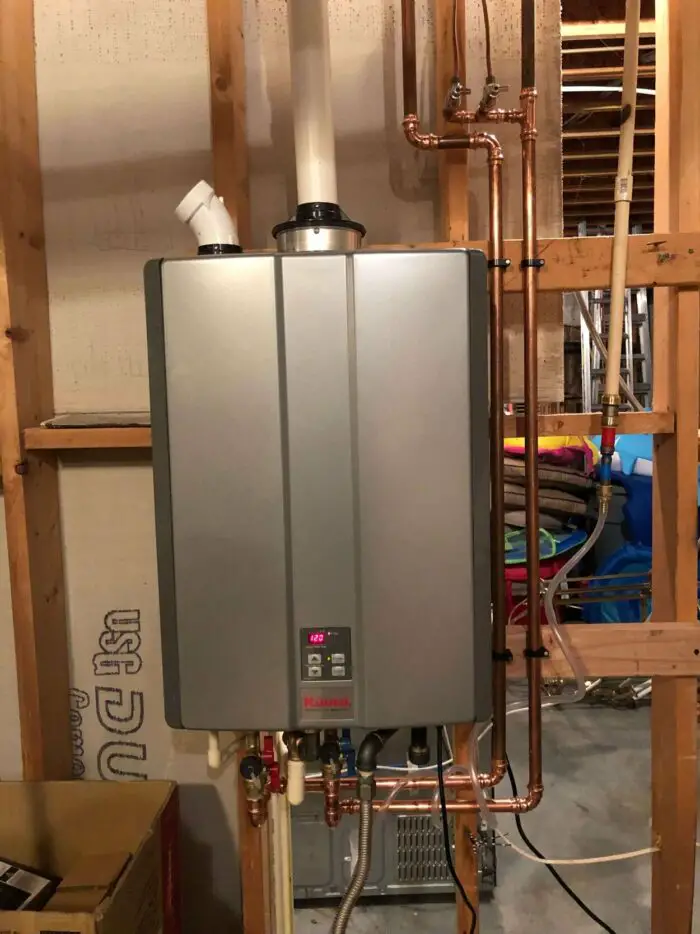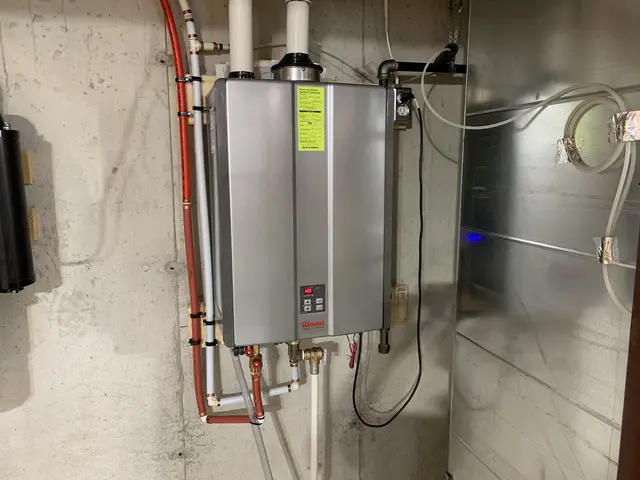Rinnai Tankless Water Heater With No Hot Water
Reliable hot water is essential for everyday tasks, from showering to washing dishes. Tankless water heaters provide efficient, space-saving hot water supply in residential and commercial buildings. Rinnai is a company known for its high-quality tankless water heaters.
However, like any appliance, Rinnai tankless water heaters can run into problems over time. A common problem faced by users is the lack of hot water.
Understanding Rinnai Tankless Water Heater Operation
To properly handle a Rinnai tankless water heater, it is important to first understand how it works. Unlike traditional water heaters, tankless water heaters supply water on demand. This eliminates the need for water storage.
The tankless water works using a simple principle. When you turn on the hot water tap, cold water enters the heat exchanger which rapidly heats it to the desired temperature [1].
The water is then delivered to the point of use through the piping. After a certain period of use, the system may develop some problems. Several factors may contribute to the lack of hot water when you turn on your Rinnai tankless water heater. The factors are discussed below
Rinnai Tankless Water Heater with No Hot Water Causes

- Cross-Connections in Plumbing
A plumbing reverse connection is one of the reasons why your tankless water heater not may not delivering water. You will not receive hot water from the unit if there is a reverse connection.
In this case, a reverse connection implies connecting the hot water lines to the cold water intake and the cold water lines to the hot water inlet [2].
Furthermore, a malfunctioning mixing valve might result in the hot and cold water crossing.
- Insufficient Gas Supply
Inadequate gas supply can hinder heating, resulting in a lack of hot water. Inspect the gas valve and ensure it is fully open. Also, check if other gas appliances are functioning correctly to rule out a gas supply issue.
Verify that the gas line is connected correctly and not damaged [3].
If the pilot light on the heater is damaged, follow the manufacturer’s instructions to fix it.
- Insufficient Water Flow
Insufficient water flow can cause a Rinnai tankless water heater not to produce hot water. Factors contributing to low water flow include clogged aerators, partially closed valves, and a malfunctioning flow sensor.
Clogged aerators can accumulate mineral deposits and debris, limiting water flow. To resolve this issue, unscrew, clean, and reattach the aerator [4].
Check that all of the valves in the plumbing system, including the shut-off valve, are fully open.
Clean the flow sensor according to the manufacturer’s directions or contact a plumber if the flow sensor is malfunctioning or dirty.
- Ignition Failure
Ignition failure is another common issue that can prevent a tankless Rinnai water heater from producing hot water. If the ignition does not work correctly, the heating process cannot start, leading to a shortage of hot water.
Ignition failures occur for various reasons, including gas supply problems, dirty or damaged ignition components, or control panel problems. Check for error codes or blinking lights on the control panel that indicate an ignition problem [5].
Ensure the gas supply is connected correctly and the ignition components are clean and intact.
If the unit uses electronic ignition, ensure the igniter functions appropriately. Contact a technician if necessary to fix this problem. Furthermore, ensure the ventilation system is clear of obstructions, including air intake and exhaust vents, to prevent ignition issues.
- Coldwater sandwich effect
The cold water sandwich effect is intermittent in tankless water heaters. This is where a burst of cold water is produced during hot water usage. This effect disrupts the expected continuous flow of hot water and gives the impression of no hot water.
The cold water sandwich effect is caused by the operating characteristics of tankless water heaters [6].
The heater typically warms water on demand as it flows through the unit. Factors contributing to the cold water sandwich effect include thermal inertia, temperature variations, and residual hot water flushing out.
To mitigate the effect, adjust temperature settings, install recirculation systems, and add flow restrictors to plumbing fixtures.
- Heat exchanger scaling
Heat exchanger scaling occurs when mineral deposits like calcium and magnesium build up on the heat exchanger surfaces in a tankless water heater. These deposits form an insulator, reducing heat transfer efficiency. They also cause issues like reduced heating efficiency, increased energy consumption, and potential damage to the heat exchanger.
Regular maintenance and descaling are essential to address scaling issues [7].
The manufacturer’s user manual typically includes instructions for descaling the heat exchanger. In case of severe scaling, professional assistance is recommended.
Regular maintenance ensures optimal performance and prolongs the lifespan of the Rinnai tankless water heater.
- Faulty temperature sensors or heating elements
Malfunctioning temperature sensors or heating elements can prevent the water heater from heating water adequately. These components are crucial for measuring and regulating water temperature, ensuring consistent hot water production.
Faulty temperature sensors can cause inaccurate readings or incorrect signals. This prevents the unit from activating heating elements and heating water to desired temperatures.
To address these issues, contact a plumber with experience in Rinnai tankless water heaters. They can perform diagnostic testing, recommend replacements, and handle the installation of new temperature sensors or heating elements.
- Overheating Limit Switch Activation
Rinnai tankless water heaters have an overheat limit switch that shuts off the unit if the temperature exceeds a certain threshold. This can occur due to a dirty heat exchanger or restricted airflow.
Clean the heat exchanger and ensure proper ventilation to prevent overheating.
Troubleshooting Guidelines for Rinnai Tankless Water Heater

- Ensure that the unit is receiving power. Check if the circuit breaker or fuse associated with the water heater is functioning correctly. Reset the breaker or have the fuse replaced if necessary.
- Check the plumbing connections. Confirm that the cold water line is connected to the cold inlet and the hot water line is connected to the hot inlet. Next, determine if there is noticeable damage to the mixing valve. If it fails to work, consider replacing it.
- Ensure the cold water supply valve leading to the water heater is open, and water flows into the unit.
- If your Rinnai tankless water heater operates on natural gas, ensure the supply valve is open and the gas line is connected correctly. Check that all other gas appliances in your home are working properly.
- Examine the ignition components such as the spark igniter or flame rod for dirt, damage, or corrosion. Use a gentle brush or towel to carefully clean them. Any component that is significantly damaged should be replaced to prevent further problems.
- Rinnai tankless water heaters have built-in diagnostic systems that display error codes on the control panel. Examine the control board for error codes or symptoms of a problem. Consult the user manual to interpret error codes displayed or contact customer service for assistance.
- If you have followed the instructions above and still encounter ignition failure, it is good that you seek the aid of a certified technician or contact Rinnai customer care. They are qualified to identify complicated problems and propose appropriate solutions.
Additional Tips and Considerations
When fixing Rinnai tankless water heater with no hot water issues, you should keep these considerations in mind. These factors can help you identify and address the underlying problems causing the lack of hot water.
Let’s explore several of these components to understand how they help solve your Rinnai tankless water heater’s “no hot water” problem.
- Temperature settings
Check the temperature settings on your Rinnai tankless water heater. Ensure that the desired hot water temperature is appropriately set.
If the temperature is too low, you may conclude there is no hot water. Therefore, customize the temperature settings on the control panel to suit your preferences.
- Insulation and venting
Proper insulation and venting are crucial for efficiently operating a tankless water heater. Inadequate insulation or improper venting can lead to heat loss or restricted airflow, affecting the unit’s performance.
Inspect the insulation around the water heater and hot water pipes to ensure they are insulated. Also, check the venting system for any blockages or obstructions and clear them if necessary. Consider consulting a professional to evaluate the insulation and venting setup. [8]
- Water quality considerations
Water quality can impact the performance and longevity of your Rinnai tankless water heater. Hard water, high mineral content, or excessive sediment can contribute to scaling and reduce the unit’s efficiency.
If you discover your water is low quality, consider installing a water softener or a water filtration system to reduce mineral deposits and sediment. Regular maintenance and periodic descaling can also help mitigate the effects of water hardness.
- Professional servicing and maintenance
While homeowners can perform many troubleshooting steps, seeking professional assistance for complex issues is advisable. Plan a regular maintenance schedule with a qualified technician. They can inspect and service the unit, including descaling, checking the gas pressure, and verifying the overall performance.
- Warranty coverage
If your Rinnai tankless water heater is still within the warranty period and you have exhausted all troubleshooting methods without success, contact Rinnai or the authorized dealer from whom you purchased the unit. Provide details of the issue and follow their instructions regarding warranty coverage, repair, or replacement options.
Read Also: Rhem vs Ao Smith
Conclusion
A Rinnai tankless water heater not delivering hot water can be a frustrating experience. Nonetheless, by following the troubleshooting guidance given in this article, you may detect and address typical flaws.
Consult the user manual, consider professional assistance when needed, and maintain regular servicing.
All this will ensure you experience optimal performance and longevity with your Rinnai tankless water heater. You will also enjoy the benefits of continuous hot water once the issue is resolved.
Read Next: Rinnai RUR160iN Review

Michael Davis is a heating & plumbing expert who currently works as independent contractor in SC. He also writes for Plumbertip.
For almost 10 years he worked on various plumbing tasks across South Carolina.



